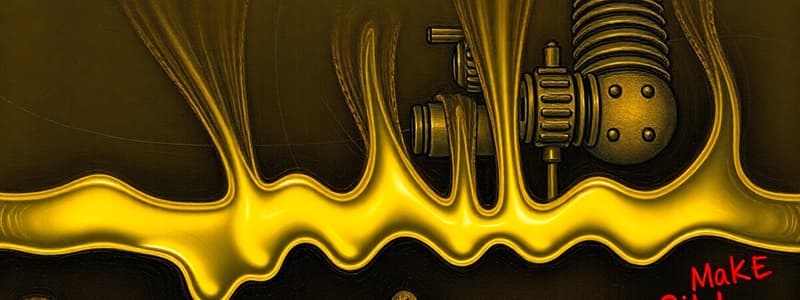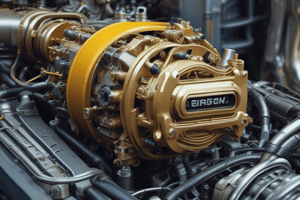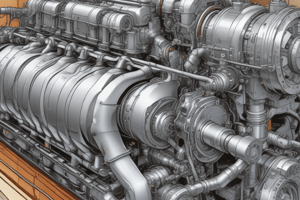Podcast
Questions and Answers
What percentage of normal engine wear can occur during the start-up cycle due to inadequate lubrication?
What percentage of normal engine wear can occur during the start-up cycle due to inadequate lubrication?
- 20 percent
- 80 percent (correct)
- 30 percent
- 50 percent
Which property of engine oils is particularly beneficial at low temperatures to reduce wear?
Which property of engine oils is particularly beneficial at low temperatures to reduce wear?
- Ease of flow (correct)
- High viscosity
- Low volatility
- High flash point
For which type of aircraft engines are ashless dispersant grades particularly recommended?
For which type of aircraft engines are ashless dispersant grades particularly recommended?
- Fuel-efficient engines
- Turbocharged series engines (correct)
- Water-cooled engines
- Piston engines only
The term 'premiummultigrade ashless dispersant oil' refers to what type of oil composition?
The term 'premiummultigrade ashless dispersant oil' refers to what type of oil composition?
What is the usual requirement beneath 20°F (-6°C) for engine and oil supply in most engines?
What is the usual requirement beneath 20°F (-6°C) for engine and oil supply in most engines?
What is the approximate weight of water per gallon?
What is the approximate weight of water per gallon?
Which specific gravity value corresponds to oil weighing 7.2 pounds per gallon?
Which specific gravity value corresponds to oil weighing 7.2 pounds per gallon?
What are the straight oil grades mentioned for mineral oils in aircraft engines?
What are the straight oil grades mentioned for mineral oils in aircraft engines?
What is typically included in straight weight mineral oils aside from a pour point depressant?
What is typically included in straight weight mineral oils aside from a pour point depressant?
During which phase is straight weight mineral oil typically used in aviation engines?
During which phase is straight weight mineral oil typically used in aviation engines?
What was the first type of additives used in straight mineral piston engine oils?
What was the first type of additives used in straight mineral piston engine oils?
What is a key disadvantage of using metal-containing additives in engine oils?
What is a key disadvantage of using metal-containing additives in engine oils?
Which characteristic is NOT typically associated with straight mineral piston engine oils?
Which characteristic is NOT typically associated with straight mineral piston engine oils?
What type of oil should be used for the first 25 hours of operation in a new aircraft engine?
What type of oil should be used for the first 25 hours of operation in a new aircraft engine?
What can the use of ashless dispersant oil in a new or newly overhauled engine potentially lead to?
What can the use of ashless dispersant oil in a new or newly overhauled engine potentially lead to?
What is a primary advantage of multigrade oil compared to monograde oil?
What is a primary advantage of multigrade oil compared to monograde oil?
After replacing one or more cylinders in an aircraft engine, what type of oil should be used until oil consumption stabilizes?
After replacing one or more cylinders in an aircraft engine, what type of oil should be used until oil consumption stabilizes?
Why should the preservative oil in a new engine be removed at the end of the first 25 hours of operation?
Why should the preservative oil in a new engine be removed at the end of the first 25 hours of operation?
Why is a blend of synthetic and mineral-based oil used in multigrade oils?
Why is a blend of synthetic and mineral-based oil used in multigrade oils?
What characteristic of multigrade oils contributes to their exceptional antifoaming performance?
What characteristic of multigrade oils contributes to their exceptional antifoaming performance?
What should be done when oil consumption stabilizes after initial operation of a new engine?
What should be done when oil consumption stabilizes after initial operation of a new engine?
What does the presence of a high viscosity index in multigrade oils indicate?
What does the presence of a high viscosity index in multigrade oils indicate?
Which property of multigrade oil allows it to lubricate effectively over a wider temperature range?
Which property of multigrade oil allows it to lubricate effectively over a wider temperature range?
What is a significant characteristic of ashless dispersant oils used in aviation piston engines?
What is a significant characteristic of ashless dispersant oils used in aviation piston engines?
Which property of the additives in mineral oils primarily helps in maintaining viscosity at varying temperatures?
Which property of the additives in mineral oils primarily helps in maintaining viscosity at varying temperatures?
How do the nonmetallic additives in W oils affect engine performance during climatic changes?
How do the nonmetallic additives in W oils affect engine performance during climatic changes?
What is the role of dispersancy in ashless dispersant oils?
What is the role of dispersancy in ashless dispersant oils?
Which of the following is NOT a feature of ashless dispersant oils?
Which of the following is NOT a feature of ashless dispersant oils?
What advantage does semi-synthetic multigrade oil like SAE W15 W50 provide for piston engines?
What advantage does semi-synthetic multigrade oil like SAE W15 W50 provide for piston engines?
What characteristic is essential for an oil to be classified as an ashless dispersant?
What characteristic is essential for an oil to be classified as an ashless dispersant?
What is a primary benefit of using W oils in reciprocating engines?
What is a primary benefit of using W oils in reciprocating engines?
What primarily prevents metal-to-metal contact in an engine with fluid lubrication?
What primarily prevents metal-to-metal contact in an engine with fluid lubrication?
What type of friction occurs when gear teeth interact under pressure?
What type of friction occurs when gear teeth interact under pressure?
How does oil assist in the cooling of aircraft engines?
How does oil assist in the cooling of aircraft engines?
What key characteristic determines the suitable viscosity of engine oil under varying temperatures?
What key characteristic determines the suitable viscosity of engine oil under varying temperatures?
Which type of oil is typically preferred to avoid excessive thickening in cold temperatures?
Which type of oil is typically preferred to avoid excessive thickening in cold temperatures?
What common method is used to classify aviation oils by their viscosity?
What common method is used to classify aviation oils by their viscosity?
What happens to oil if it becomes too thin at high temperatures?
What happens to oil if it becomes too thin at high temperatures?
Which factor is NOT crucial in selecting the proper oil grade for an engine?
Which factor is NOT crucial in selecting the proper oil grade for an engine?
What is the intended result of the oil's cleaning function in an engine?
What is the intended result of the oil's cleaning function in an engine?
What occurs when the oil's coating is not maintained during engine shutdown?
What occurs when the oil's coating is not maintained during engine shutdown?
What type of oil is indicated by a designation such as SAE 20W50?
What type of oil is indicated by a designation such as SAE 20W50?
Which characteristic of oil indicates its ability to withstand high temperatures?
Which characteristic of oil indicates its ability to withstand high temperatures?
Why are the SAE ratings arbitrary and not directly related to quality?
Why are the SAE ratings arbitrary and not directly related to quality?
Flashcards
What is the weight of one gallon of water?
What is the weight of one gallon of water?
One gallon of water weighs approximately 8 pounds.
How do you calculate the weight of oil per gallon?
How do you calculate the weight of oil per gallon?
Multiply the specific gravity of the oil by the weight of a gallon of water (8 pounds).
What are Straight Mineral Oils?
What are Straight Mineral Oils?
Straight mineral oils are used as lubricants for reciprocating engines, blended from petroleum base stocks with high-viscosity index.
What are the oil grades for Straight Mineral Oils?
What are the oil grades for Straight Mineral Oils?
Signup and view all the flashcards
What additives are typically included in Straight Mineral Oils?
What additives are typically included in Straight Mineral Oils?
Signup and view all the flashcards
When are Straight Mineral Oils used?
When are Straight Mineral Oils used?
Signup and view all the flashcards
What are the disadvantages of using early mineral oil additives?
What are the disadvantages of using early mineral oil additives?
Signup and view all the flashcards
What were the performance benefits of early mineral oil additives?
What were the performance benefits of early mineral oil additives?
Signup and view all the flashcards
Multigrade Oil
Multigrade Oil
Signup and view all the flashcards
Monograde Oil
Monograde Oil
Signup and view all the flashcards
Cold-Start Protection
Cold-Start Protection
Signup and view all the flashcards
Lubricant Film
Lubricant Film
Signup and view all the flashcards
Viscosity Index
Viscosity Index
Signup and view all the flashcards
Start-up Wear
Start-up Wear
Signup and view all the flashcards
Oil Flow Importance
Oil Flow Importance
Signup and view all the flashcards
Ashless Dispersant Oil
Ashless Dispersant Oil
Signup and view all the flashcards
Preheating Oil
Preheating Oil
Signup and view all the flashcards
Premium Multigrade Oil
Premium Multigrade Oil
Signup and view all the flashcards
Dispersancy
Dispersancy
Signup and view all the flashcards
Viscosity Stabilizing Effect
Viscosity Stabilizing Effect
Signup and view all the flashcards
Why Were Ashless Dispersant Oils Developed?
Why Were Ashless Dispersant Oils Developed?
Signup and view all the flashcards
What is the role of additives in Ashless Dispersant Oils?
What is the role of additives in Ashless Dispersant Oils?
Signup and view all the flashcards
How do Ashless Dispersant Oils Extend Operating Temperature Range?
How do Ashless Dispersant Oils Extend Operating Temperature Range?
Signup and view all the flashcards
Do Ashless Dispersant Oils Clean Previous Deposits?
Do Ashless Dispersant Oils Clean Previous Deposits?
Signup and view all the flashcards
What is the purpose of preservative oil in new engines?
What is the purpose of preservative oil in new engines?
Signup and view all the flashcards
When should preservative oil be removed from an aircraft engine?
When should preservative oil be removed from an aircraft engine?
Signup and view all the flashcards
What type of oil should be used during the engine break-in period?
What type of oil should be used during the engine break-in period?
Signup and view all the flashcards
Why should ashless dispersant oils be avoided during engine break-in?
Why should ashless dispersant oils be avoided during engine break-in?
Signup and view all the flashcards
When is it appropriate to switch to ashless dispersant oil?
When is it appropriate to switch to ashless dispersant oil?
Signup and view all the flashcards
Primary purpose of engine lubricant
Primary purpose of engine lubricant
Signup and view all the flashcards
Why are liquid oils used for aircraft engines?
Why are liquid oils used for aircraft engines?
Signup and view all the flashcards
Fluid lubrication principle
Fluid lubrication principle
Signup and view all the flashcards
Types of friction in engines
Types of friction in engines
Signup and view all the flashcards
Sliding friction
Sliding friction
Signup and view all the flashcards
Rolling friction
Rolling friction
Signup and view all the flashcards
Wiping friction
Wiping friction
Signup and view all the flashcards
Functions of engine oil: Reducing friction
Functions of engine oil: Reducing friction
Signup and view all the flashcards
Functions of engine oil: Cooling
Functions of engine oil: Cooling
Signup and view all the flashcards
Functions of engine oil: Preventing leakage
Functions of engine oil: Preventing leakage
Signup and view all the flashcards
Functions of engine oil: Cleaning
Functions of engine oil: Cleaning
Signup and view all the flashcards
Functions of engine oil: Preventing corrosion
Functions of engine oil: Preventing corrosion
Signup and view all the flashcards
Viscosity of oil
Viscosity of oil
Signup and view all the flashcards
Flash point and fire point of engine oil
Flash point and fire point of engine oil
Signup and view all the flashcards
Study Notes
Engine Lubrication Principles
- Lubrication's primary function is to reduce friction between moving parts.
- Liquid lubricants (oils) are commonly used in aircraft engines.
- Lubricants are readily circulated.
- Ideal lubrication theoretically creates a separation between surfaces, preventing metal-to-metal contact.
Types of Friction
- Engines experience various friction types.
- Sliding friction occurs when one surface moves across another.
- Microscopic surface imperfections cause sliding friction.
- Sliding friction is frequently found in plain bearings.
- Rolling friction is produced when a roller or sphere moves on a surface.
- Rolling friction, seen in ball bearings, creates less friction than sliding friction.
- Wiping friction occurs between gear teeth.
- Pressure on gear teeth can significantly vary.
Engine Oil Functions
- Engine oil reduces friction.
- It acts as a cushion between metal parts.
- Oil cooling is crucial, as heat generation is common.
- Oil absorbs heat from engine components.
- Engines with reciprocating actions often utilize oil.
- This absorption of heat can account for up to 50% of a reciprocating engine's cooling.
- Oil prevents leakage.
- Oil holds particles in suspension.
- Oil cleans the engine.
- Oil prevents corrosion by creating a coating.
Reciprocating Engine Lubricant Requirements and Characteristics
- Various essential properties characterize satisfactory reciprocating engine oil.
- Viscosity is crucial for operation.
- Oil that flows readily has low viscosity.
- Oil that flows slowly has high viscosity..
- Viscosity changes with temperature.
- Oil viscosity changes as temperatures vary significantly.
- High viscosity index oils provide consistent viscosity across different temps.
- Flash point and fire point are critical; they determine the temp at which oil generates ignitable gases or flames.
- Cloud point and pour point specify the temperatures at which oil's wax content solidifies or solidifies and can flow.
- Specific gravity is the ratio of oil weight versus an equal volume of water at a specific temperature.
Rotary Gear Pumps and Vane Pumps
- Rotary gear pumps and vane pumps are examples of types of lubricating pumps.
- They are often used as part of a comprehensive system for lubrication.
Classification of Oils
- Aviation oils are frequently categorized by their viscosity using numbers.
- SAE viscosity ratings for oils are often used for classification.
- SAE ratings are purely arbitrary.
Viscosity Index
- Viscosity index is a crucial feature of reciprocating engine oils, and is a numerical value that describes the extent to which viscosity changes with temperature.
- It's important for stable performance amidst wide temp ranges.
- High viscosity index oil maintains consistent viscosity, regardless of temperature variations.
Mineral Oils
- Early aircraft often used straight mineral oils.
- Mineral oils have excellent oxidative properties.
Ashless Dispersant Oils
- Developed to address the limitations of mineral oils.
- They contain additives that improve viscosity and reduce the tendency of oil to thin at high temps or thicken at low temps.
- They often use synthetic and mineral oil blends.
Other Considerations
- Aircraft manufacturers add preservatives for additional lubrication protection.
- The preservative oil is typically removed after 25 hours of operation.
- Mineral oil should be used after the replacement of cylinders, until consumption is stabilized.
Studying That Suits You
Use AI to generate personalized quizzes and flashcards to suit your learning preferences.




